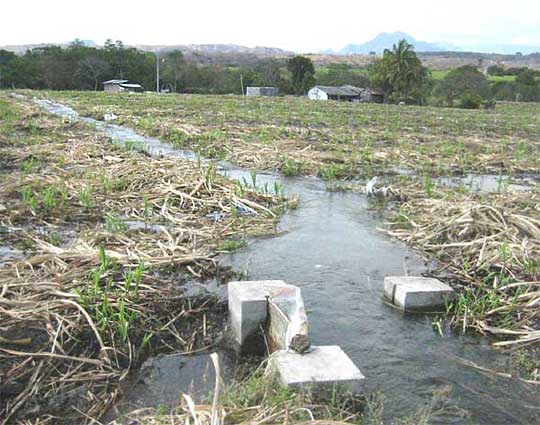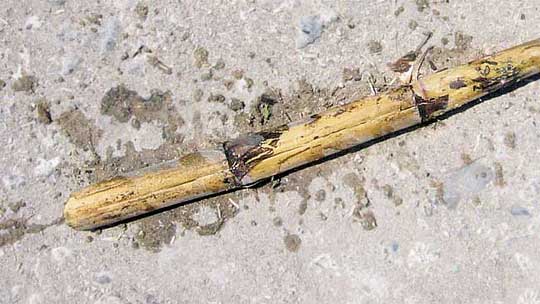Excerpts from Jim Conrad's
Naturalist Newsletter
from the March 17, 2008 Newsletter written in the community of 28 de Junio, in the Central Valley 8 kms west of Pujiltic, Chiapas, MÉXICO
SUGARCANE CULTIVATION
On Mondays when I visit the cyber in Pujiltik, before reaching the paved road where I can catch a minibus to town, I hike about half an hour through sugarcane fields. In most places this amounts to passing down an alley with impenetrable sugarcane walls 12 to 15 feet high. In other places you can see scenes such as the one shown below:

In that view sugarcane recently has been cut and now the field is being irrigated while new, foot-tall sugarcane shoots are emerging from the plant's perennial stem-bases. The shoots grow tall, when they're mature and most of the lower leaves are dried out and light brown, the field undergoes a spectacular controlled burn that cinderizes the dead leaves and makes the sugar in the thick stem easier to remove. The stalks are then cut and trucked to the big sugar mill in Pujiltik, and back in the fields the process begins all over again.
Many streams traverse our area, descending from the rainier Chiapas highlands immediately to our north. Over the centuries a complex network of irrigation canals has been developed, one consequence of which is that natural rivers are pretty much dry at this time of year. The canal in the picture runs atop a low ridge, enabling water to escape on both sides in a more or less haphazard but fairly effective manner. Note the concrete gates with their plywood barriers fitting into grooves. Once the field before us is watered the plywood barrier can be shifted to the farthest gates and if the gate as the left is left open water will run toward the left.
I'm told that you have to renew the perennially sprouting sugarcane stems after five to ten years. The exact time seems to be a matter of debate, some saying that for maximum sugar-producing efficiency you should renew every five years, others swearing that you're wasting money if you replant sooner than every eight to ten years.
I've read that no other crop converts air and water to carbohydrate as efficiently and prodigiously as sugarcane. This places sugarcane at the heart of a great debate currently being conducted with regard to biofuel production. On the one hand, Brazil being the largest sugarcane producer, it's feared that that country will convert its Amazon rainforest, "Earth's lungs," to sugarcane. On the other hand, many, especially here in Mexico, say that with sugarcane so much more productive, we shouldn't be converting corn and other edible grain to biofuel because people need to eat that grain.
I've heard few suggestions that people need to travel less and, especially in North America, walk and bike more, and use mass transit, so I'll voice that opinion here. And to be even more provocative I'll say that we need to reduce our appetites and numbers drastically.
Sugarcane is a grass, SACCHARUM OFFICINARUM. The last I heard it was considered to be a long-cultivated horticultural form of a wild grass species not yet identified, probably to be found in Asia.
from the March 24, 2008 Newsletter written in the community of 28 de Junio, in the Central Valley 8 kms west of Pujiltic, Chiapas, MÉXICO
SUGARCANE FLOWERS
My Bailey's Manual of Cultivated Plants says that sugarcane doesn't flower in North America. Down here you often see it flowering, as shown below:

The inflorescence on the right in the picture is about two feet tall. Many of you will recognize the inflorescence's shape and the white-fuzzed fruits as being similar to those of broomsedge and plumegrass. That makes sense since they're all closely related.
Don Bartolomé tells me that around here two kinds of sugarcane are grown but only one produces flowers. Weakley's Flora of the Carolinas lists four distinct species of the genus Saccharum cultivated under the name of sugarcane, with many varieties and hybrids of the four. The Latin name usually given is SACCHARUM OFFICINARUM. I can't say whether the two types grown here are different species or just different varieties of one, probably of Saccharum officinarum.
Roadsides here are particularly trashy looking right now because the big sugarcane trucks always travel so heavily loaded that canes perpetually fall off. When a car flattens a sugarcane stem in the road you can see just how much sugar-water is inside, as shown below:

One nice thing, though, is that the whole landscape smells faintly of molasses.